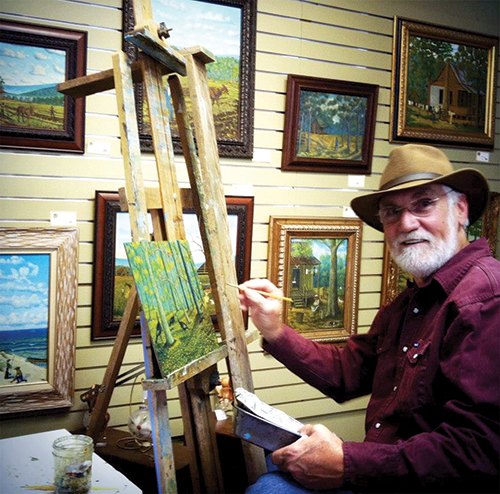Gallery introduces artists to national audience

Black Belt artist Stephen James likes traveling, both to the country and sometimes through time to a simpler, less frantic past.
“Some of my fondest memories are of staying with my grandfather, who was a tenant farmer,” said James, who lives in rural Monroe County. “Everyone picked cotton by hand, and there were chicken and cattle.”
But it’s not just James who sees those memories of Alabama farm life from long ago. Thousands witness them at the Black Belt Treasures Cultural Arts Center in the paintings that James has created.
The center opened in Camden as a way to attract tourists to Alabama’s Black Belt. The Black Belt is one of the poorest areas of the state, and is called the “Black Belt,” because of its black soil where most of the state’s cotton was once grown.
Since opening in 2005, the center has grown from representing 75 artists to more than 450.
And those artists, who include painters, sculptors, potters, basket-weavers, quilters, woodworkers and others, have succeeded in attracting tourists to the area. So far Black Belt Treasures has attracted visitors from all 50 states and more than 26 countries.
It has also helped those tourists discover artists such as James, the 62-year-old painter who has discovered his visions of the past now have a bright future.
Of course, James also paints the present, but whether past or present most of his subjects are found in rural areas of the state that you can only get to by winding dirt roads.
“I like country scenes, family scenes, scenes that emphasize the fun you can have in the country and that emphasize family values,” he said. One of his favorite things to draw is country churches.
James has been selling his paintings for almost 40 years, but because of Black Belt Treasures and the Monroe County Heritage Museum, he said he has sold more paintings in the past five years than in the other 35 combined.
He said he has been drawn to art since he was 3 or 4 and his father showed him how to draw a cowboy.
He was about 10 when his parents began to realize he had talent. They had gotten him a paint-by-the-numbers set.
“After I painted the dog on the front by the numbers, I turned it around, and on the back, I did a country scene,” he said.
In school, he was always sketching and drawing and doodling, but never considered art as a career.
Instead, he graduated from nursing school in 1977 and has worked as a nurse ever since.
But he never completely spurned his love of art.
 When he was around 20, he started doing oil paintings. He gave the first two paintings he did to his parents, who he said were incredibly supportive.
When he was around 20, he started doing oil paintings. He gave the first two paintings he did to his parents, who he said were incredibly supportive.
And through the years, he developed his own style.
“I guess you could say I am self-taught,” he said. “I took one class in college, but the teacher seemed a lot more interested in drama than art.”
“As far as technique, I pretty much developed mine by just doing it and experimenting. And maybe that has helped me. If I had a lot of instruction, I’d be doing paintings more like other people do. Now, I have my own style.”
Occasionally he said he would sell a painting, usually to people who lived in the country, but mainly he continued because he loved painting country scenes. Then a strange thing happened. After a lifetime of drawing and painting, his career started to blossom when he was in his late 50s.
Now in his 60s, he still works as a nurse part time, but spends about 30 hours a week painting. Sometimes he regrets that painting takes time away from his other “hobbies,” which include fishing, gardening and “maintaining a good bit of land.” But he doesn’t regret it often. He says he loves what he does.
He credits his success to his family, including his sharecropping grandfather, his dad, who he says is still the best man he’s ever known, and his wife Sheila James, who has encouraged him ever since they got married 30 years ago.
In the future he plans to do a collection of country churches.
“I want to paint them just because it seems country churches are just some of the prettiest scenes you can find in the country,” he said. “I think those have been some of my favorite things to paint.”
He likes painting country churches even though some of them don’t sell.
“Usually when I do one that I really like, my wife takes it so I don’t get to sell it,” he said laughing.
Black Belt Treasures Cultural Arts Center
209 Claiborne St.
Camden, AL 36726
334-682-9878
Open 10 a.m.–4 p.m.
Tuesday–Friday
10 a.m.–2 p.m. Saturday
video:
www.youtube.com/watch?v=p0oLR1g9jIU
Stephen James
Website:
Email:




